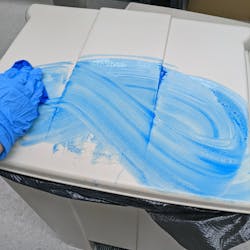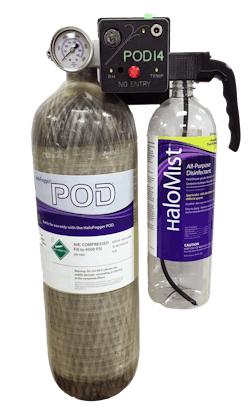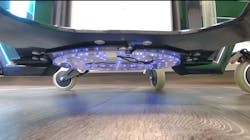New perceptions: Disinfecting air, surfaces as COVID-19 recedes
COVID-19 is the third-leading cause of death in the United States following heart disease and cancer, according to the Centers for Disease Control and Prevention (CDC)1. Furthermore, roughly 1 in 25 hospital patients catch a hospital- acquired infection (HAI) each year in the U.S2. Globally, close to 100,000 people die from HAIs3, costing hospitals and health systems billions of dollars. The significant rise in HAIs over the past two years has brought increased attention to the importance of disinfection.
Against the backdrop of the pandemic, now lingering into its third year, Healthcare Purchasing News asked several manufacturers for insights about cleaning and disinfecting the air and surfaces of bacterial and viral microbes.
No ESKAPE
More than 40% of HAIs are due to ESKAPE pathogens (Enterococcus faecium, Staphylococcus aureus, Klebsiella pneumoniae, Acinetobacter baumannii, Pseudomonas aeruginosa, and Enterobacter species)4. In response to pathogens’ capability to recontaminate surfaces or equipment over a 24-hour period, PDI Healthcare, a manufacturer of infection prevention products and services, recently launched Sani-24 wipes that protect against pathogens in one minute.
“This product helps solve several common problems encountered within healthcare disinfection, including the inability to disinfect surfaces/equipment as often as they need due to constrained resources (i.e., FTEs, time, or supplies). Additionally, this product’s formulation can also help with high-touch surfaces within high-traffic areas (i.e., elevators, waiting rooms, public bathrooms, ATMs/kiosks, etc.) by providing 24-hour disinfecting coverage. Lastly, when used as a routine disinfectant, repeated applications of Sani-24 wipes can provide coverage for areas that may have been missed during a previous cleaning process or subsequent uses therefore reducing potential gaps,” according to Debra A. Hagberg, MT(ASCP), CIC, Director, Clinical Affairs, PDI.
Kinnos, a specialized developer of disinfectant applications, noticed that disinfection could only be calculated after it was done, with microbial sampling, ATP [adenosine triphosphate] testing, or fluorescent markers. Ready-to-Use (RTU) wipes are ubiquitous, but spots on surfaces are often missed, according to Katherine Jin, Chief Technology Officer, Kinnos.
“Research shows that inadequate disinfection is the root cause of a huge portion of healthcare-associated infections. Disinfectants and ready-to-use (RTU) wipes are all transparent on application, so workers can’t see what they are wiping and what they’ve missed. Our colorant for bleach and RTU wipes lets workers finally see where they’ve wiped, and empowers them to self-monitor their own coverage,” she said. Kinnos launched its Highlight for Bleach Wipes in mid-2021, a lid and cartridge addition to bleach wipes. The wipes are then used to clean a surface and the Highlight will color it blue. If the area is thoroughly disinfected, the blue will fade.
Jin suggests doing multiple passes while disinfecting a surface. “Our teams have seen a real gap in consistency of how everyone wipes with these tools. Some wipe in a zig zag, some circle their hand, but few do multiple passes. Wipe manufacturers don’t instruct on this. Our research indicates that multiple passes doesn’t take longer but improves the removal of dirt and reduction of microbes,” said Jin.
While healthcare facilities are dedicated to effective and thorough disinfection, they also strive to achieve quick turnover times. Facilities are experiencing unprecedented shortages in staff and increased turnover, which can increase the risk of error, according to Larinda Becker, Executive Director of Marketing, Infection Prevention for Diversey, a manufacturer of cleaning and hygiene products. She suggests that “Suppliers can help address these issues with turnkey solutions that can simplify and streamline processes, allowing facilities to make it easier for staff while reducing the risks of transmission and infection.”
Diversey designed Oxivir 1, a wipe that is bactericidal, virucidal, fungicidal and tuberculocidal in one minute. Diversey also developed a four-step cleaning process approach to help customers reevaluate their practices:
1. Access facility needs and objectives
2. Select cleaning methods and products
3. Validate cleaning effectiveness
4. Implement training program and materials
We’re just not compatible
Compatibility with medical devices is one of the most challenging areas for surface disinfection, according to Hagberg, PDI. She highlights two focus areas:
1. Compatibility of the disinfectant chemistry with the actual material of the surface
2. Compatibility of the disinfectant solution with the actual functionality of medical devices that the disinfectant is used on
“The U.S. Food and Drug Administration (FDA) requires manufacturers of medical devices to test at least one disinfectant on the medical device for compatibility against corrosion/visual impact and impaired functionality. If the medical device manufacturer tests a specific brand of disinfectant, that product(s) is then listed in the cleaning/disinfection instructions for use (IFU) in the product manual.
“The healthcare facility must then comply with the medical device IFU and comply with the disinfectant IFU. Problems can arise when the facility does not use the specific brand listed in the device manual because this can lead to either a non-compliance issue, if another disinfectant brand is used, or the required purchase of several different disinfectants to meet the needs of the medical device instructions,” she said.
Healthcare’s numerous medical devices continually complicate the practice of surface disinfection. “Each device may have a different disinfectant listed, or the instructions for the disinfectant contact time may not be correct,” Hagberg continued. “This can result in a compliance concern, especially if the user follows the device IFU correctly, the disinfectant IFU is not complied with, or vice versa.”
Medical equipment surfaces can be costly to replace and Clorox cleaner disinfectant Spore Defense has a broad surface compatibility to protect medical equipment, according to Kristina Vannoni, Associate Marketing Director, Clorox Healthcare. “Healthcare facilities have and will continue to be challenged with preventing the spread of pathogens that contribute to healthcare-associated infections (HAIs), especially with the rise of antibiotic resistant pathogens, such as drug-resistant Candida auris (C. auris). Drug-resistant C. auris can survive on surfaces for prolonged periods and its primary route of transmission is contact with contaminated environmental surfaces such as medical equipment, fomites and person-to-person. Continued focus on routine cleaning and disinfection of high-touch surfaces is critical to keeping healthcare facilities as safe and healthy as possible,” she emphasized.
Michele Padovan, Product Education Specialist for Angelini Pharma, a producer of dialysis infection control products, says that a dilution wipe is a good choice disinfectant for a dialysis area. “Consideration for avoidance of degradation of the expensive hardware and machinery is crucial. With the correct dilution of chlorine, this can be avoided, and a ready-to-use wipe is an obvious choice,” she said.
Scratching beyond the surface
Three-quarters of surfaces in rooms remain untouched after cleaning with only mops, buckets and rags5. “The sanitation industry has been fraught with challenges due to a long-standing reliance on traditional tools that take an unrealistic amount of time to effectively clean, sanitize or disinfect surfaces well enough to eliminate pathogens,” according to Rich Prinz, Global Vice President of Sales, EvaClean Infection Prevention Solutions by EarthSafe. He further emphasized that the use of toxic cleaning and disinfectant chemicals cause more harmful health hazards.
“By eliminating 90% of the chemicals used to clean and disinfect and replacing them with a safer solution, EvaClean is able to standardize processes and simplify training, thereby reducing the risk of errors. Standardization also increases compliance and safety for staff and patients. Standardizing chemicals and dilution rates means fewer protocols to learn resulting in less margin for error, and replacing hazardous chemicals with safer solutions eliminates exposure risks and mixing mistakes,” Cimarelli said.
COVID-19 caused more disinfection products to emerge, but many of them use harsh chemicals, according to Brittany Buchman, Vice President of Marketing, TOMI Environmental Solutions. Pathogens are easily spread through the air and surfaces. Current methods such as manual cleaning and Quality Assurance Technicians (QATs) have issues with human error (missing spots) as well as harsh chemicals destroying sensitive equipment,” she said. TOMI manufactured the SteraPak, the most portable SteraMist system that uses ionized hydrogen peroxide (iHP) technology and removes the hassle of mixing hazardous solution.
Additionally, Maryalice St. Clair, Chief Commercial Officer of Halosil International Inc. stresses that Environmental Services (EVS) managers and Infection Preventionists should educate themselves on disinfection products. “Read the EPA label and challenge the efficacy claims of the manufacturer to be sure they are not false or exaggerated and that the product is being used according to the instructions on the EPA label,” she indicated. “For example, I have seen products that are only approved and effective for wet spray applications, being sold as fogging products without having EPA fogging use approval.”
It’s in the air, in the shadows
The area underneath all ultraviolet-C (UVC) robots is shadowed directly by the verticality of the unit, according to Brian Donahue, Director, Corporate Accounts for Finsen Technologies, a designer and manufacturer of UVC disinfection systems. “The dirtiest surface within any healthcare environment is the floor. It is the highest traffic area and airborne bioburden can settle there. So, you must clean the square footage under your UVC unit,” he said. Finsen recently launched the new THOR UVC robot, with unique UVC emitters placed directly underneath to disinfect the floor and its wheels.
Before purchasing a UVC unit for your facility, Donahue suggests researching the products. “Follow the science, especially the physics. Check the numbers on the UVC -wattage, wavelength and the manufacturer of the emitter itself - and inspect the design of the unit and details of any studies. Some of the new innovative ideas seem whiz-bang revolutionary, but most are vaporware and cannot perform to the stated claims. Demand a live webinar that will show the product in use, not a YouTube demo or panel discussion,” he said.
Mark Stibich, PhD, Co-founder and Chief Scientific Officer of Xenex Disinfection Services, says to consider evidence and experience when evaluating UV technologies. “It’s not enough to simply create a UV device. A very large number of companies have launched UV devices that were unsuccessful. To produce a UV device that meets the needs of the healthcare customer, a thorough understanding of the physics associated with UV, microbiology and hospital workflow is necessary. We partner with our customers to understand their goals and help them develop a disinfection strategy that easily fits into their existing processes,” he noted.
UVDI recommends healthcare professionals vet how simple or easy a product is to operate and to integrate it efficiently in an existing workflow. “Healthcare teams have been under tremendous strain in the last two years and the last thing they have time for is to take on clunky or cumbersome new products to use,” said Peter Veloz, Chief Executive Officer. “Products that are exceedingly simple and safe to operate are a must.”
Less focus is paid to the risk of air contamination than to surface disinfection, according to Karen Hoffmann, RN, MS, CIC, FAPIC, FSHEA, University of North Carolina School of Medicine.
“Untreated air samples in healthcare facilities on average range from 2 to 8 times more contamination than surfaces. Pathogens become aerosolized from routine activities like bedmaking, walking and flushing toilets, and take flight, presenting a risk of breathing in microscopic particles that contain potentially infectious material. Immunosuppressed and immunocompromised patients are at the highest risk in the hospital setting. Contaminated air is a risk to healthcare workers as well. Vidashield UV24 draws airborne contaminates and pathogens into the system through a discreet vent opening on the face of the fixture in the ceiling and eliminates 97% of the contaminates in the treated air resulting in a cleaner healthier environment,” she said.
References:
U.S. Centers for Disease Control and Prevention, Leading Causes of Death. www.cdc.gov/nchs/fastats/leading-causes-of-death.htm. Accessed March 9, 2022.
U.S. Centers for Disease Control and Prevention, Healthcare- Associated Infections (HAIs). https://www.cdc.gov/winnablebattles/report/hais.html. Accessed March 9, 2022.
U.S. Centers for Disease Control and Prevention, Health Topics – Healthcare-associated Infections (HAI), Provided by EvaClean. https://evaclean.com/industries/healthcare. Accessed March 9, 2022.
Boucher, et.al. Bad Bugs, No Drugs: No ESKAPE! An Update from the Infectious Diseases Society of America, Clinical Infectious Diseases 2009; 48:1–12. Provided by PDI.
EvaClean research, https://www.cdc.gov/infectioncontrol/pdf/guidelines/disinfection-guidelines-H.pdf, https://www.ncbi.nlm.nih.gov/pmc/articles/PMC6245375/, https://evaclean.com/. Accessed March 9, 2022.
The future of disinfection
HPN asked product and service suppliers for their thoughts on what is next for disinfection. Here is what they think is in the future:
 “COVID-19 has created what I call the new normal. Not only are healthcare facilities aware of the need for adequate disinfection, the public at large realizes that we’ll continue to deal with current and emerging pathogens in our future.”- Maryalice St. Clair, Chief Commercial Officer of Halosil International Inc.
“COVID-19 has created what I call the new normal. Not only are healthcare facilities aware of the need for adequate disinfection, the public at large realizes that we’ll continue to deal with current and emerging pathogens in our future.”- Maryalice St. Clair, Chief Commercial Officer of Halosil International Inc.
 “Healthcare facilities have and will continue to be challenged with preventing the spread of pathogens that contribute to healthcare-associated infections (HAIs), especially with the rise of antibiotic resistant pathogens, such as drug-resistant Candida auris. Drug-resistant C. auris can survive on surfaces for prolonged periods and its primary route of transmission is contact with contaminated environmental surfaces such as medical equipment, fomites and person-to-person. Continued focus on routine cleaning and disinfection of high-touch surfaces is critical to keeping healthcare facilities as safe and healthy as possible. Moving forward, it is also important for everyone in healthcare to continue playing a role in cleaning and disinfecting. While EVS are required to clean given areas once a day, all staff such as nurses should clean and disinfect their workspaces including high-touch surfaces such as telephones and printer control panels at least once per shift as well as clean and disinfect any patient care equipment after each use. Given the high traffic in hospitals, a sanitary environment is key to infection prevention and control efforts and to achieve this, it will mean continued collaboration among disciplines, Infection Preventionists (IPs) and EVS professionals.” - Kristina Vannoni, Associate Marketing Director, Clorox Healthcare
“Healthcare facilities have and will continue to be challenged with preventing the spread of pathogens that contribute to healthcare-associated infections (HAIs), especially with the rise of antibiotic resistant pathogens, such as drug-resistant Candida auris. Drug-resistant C. auris can survive on surfaces for prolonged periods and its primary route of transmission is contact with contaminated environmental surfaces such as medical equipment, fomites and person-to-person. Continued focus on routine cleaning and disinfection of high-touch surfaces is critical to keeping healthcare facilities as safe and healthy as possible. Moving forward, it is also important for everyone in healthcare to continue playing a role in cleaning and disinfecting. While EVS are required to clean given areas once a day, all staff such as nurses should clean and disinfect their workspaces including high-touch surfaces such as telephones and printer control panels at least once per shift as well as clean and disinfect any patient care equipment after each use. Given the high traffic in hospitals, a sanitary environment is key to infection prevention and control efforts and to achieve this, it will mean continued collaboration among disciplines, Infection Preventionists (IPs) and EVS professionals.” - Kristina Vannoni, Associate Marketing Director, Clorox Healthcare
 “The next evolution is to establish hospital level disinfection processes for every industry, and promote safer and more sustainable infection prevention practices.” - Rich Prinz, Global Vice President of Sales, EvaClean Infection Prevention Solutions by EarthSafe
“The next evolution is to establish hospital level disinfection processes for every industry, and promote safer and more sustainable infection prevention practices.” - Rich Prinz, Global Vice President of Sales, EvaClean Infection Prevention Solutions by EarthSafe
 “As SteraMist continues to assist in the fight against the COVID-19 coronavirus pandemic, history shows that there are many pathogens in this world that pose a substantial threat. TOMI continues to develop and add SteraMist products to the ever-changing world, and industry. All SteraMist products are built with iHP technology to eliminate threats, and TOMI remains innovating for a safer world. TOMI has fought Anthrax, Ebola, MERS-CoV, SARS-CoV-2 and will always be prepared for the next outbreak to ensure those at the forefront are fighting with the global standard of disinfection and decontamination.” - Brittany Buchman, Vice President of Marketing, TOMI Environmental Solutions
“As SteraMist continues to assist in the fight against the COVID-19 coronavirus pandemic, history shows that there are many pathogens in this world that pose a substantial threat. TOMI continues to develop and add SteraMist products to the ever-changing world, and industry. All SteraMist products are built with iHP technology to eliminate threats, and TOMI remains innovating for a safer world. TOMI has fought Anthrax, Ebola, MERS-CoV, SARS-CoV-2 and will always be prepared for the next outbreak to ensure those at the forefront are fighting with the global standard of disinfection and decontamination.” - Brittany Buchman, Vice President of Marketing, TOMI Environmental Solutions
 “A manufacturer should be mindful that new technology often comes with an extra cost. The healthcare world looks for effective, science-based products that manage the critical need for products that decrease Hospital-Acquired Infections (HAIs) and the ever-evolving number of antibiotic-resistance pathogens. Chlorine can provide customers with a product, in various dilutions, that can meet their surface disinfection requirements economically.” - Michele Padovan, Product Education Specialist for Angelini Pharma
“A manufacturer should be mindful that new technology often comes with an extra cost. The healthcare world looks for effective, science-based products that manage the critical need for products that decrease Hospital-Acquired Infections (HAIs) and the ever-evolving number of antibiotic-resistance pathogens. Chlorine can provide customers with a product, in various dilutions, that can meet their surface disinfection requirements economically.” - Michele Padovan, Product Education Specialist for Angelini Pharma
 “The future of disinfection includes products that easily and effectively eliminate bacteria biofilms on wet and dry surfaces while providing continuously active disinfection over longer periods of time (i.e., beyond 24 hours). In addition, there is an opportunity to provide a more accurate method of compliance monitoring. This type of technology could provide bacterial identification from surface samples in real-time while determining if the bacteria are alive or dead. Advanced technology will certainly come into play with surface disinfection.” - Debra A. Hagberg, MT(ASCP), CIC, Director, Clinical Affairs, PDI
“The future of disinfection includes products that easily and effectively eliminate bacteria biofilms on wet and dry surfaces while providing continuously active disinfection over longer periods of time (i.e., beyond 24 hours). In addition, there is an opportunity to provide a more accurate method of compliance monitoring. This type of technology could provide bacterial identification from surface samples in real-time while determining if the bacteria are alive or dead. Advanced technology will certainly come into play with surface disinfection.” - Debra A. Hagberg, MT(ASCP), CIC, Director, Clinical Affairs, PDI
 “The future is in technologies that are increasingly easy and fast to use --- that adapt to and simplify workflow versus the other way around. UV technologies that can address multiple Healthcare needs – supply chain sustainability, lessen labor strain through improved efficiency and proven effectiveness against multi-drug resistant organisms and emerging variants – will take hold.” - Peter Veloz, Chief Executive Officer, UVDI
“The future is in technologies that are increasingly easy and fast to use --- that adapt to and simplify workflow versus the other way around. UV technologies that can address multiple Healthcare needs – supply chain sustainability, lessen labor strain through improved efficiency and proven effectiveness against multi-drug resistant organisms and emerging variants – will take hold.” - Peter Veloz, Chief Executive Officer, UVDI
 “I really appreciate that we’ve seen an increased demand for evidence-based solutions. As a result of the pandemic, dozens of UV companies emerged touting all sorts of ridiculous claims. Sophisticated buyers now ask for validation that the UV technology works -- are there peer-reviewed and published studies validating that the technology can do what the sales rep says? I expect to see further demand and sophistication from UV buyers in the coming years.” - Mark Stibich, PhD, Co-founder and Chief Scientific Officer of Xenex Disinfection Services LLC
“I really appreciate that we’ve seen an increased demand for evidence-based solutions. As a result of the pandemic, dozens of UV companies emerged touting all sorts of ridiculous claims. Sophisticated buyers now ask for validation that the UV technology works -- are there peer-reviewed and published studies validating that the technology can do what the sales rep says? I expect to see further demand and sophistication from UV buyers in the coming years.” - Mark Stibich, PhD, Co-founder and Chief Scientific Officer of Xenex Disinfection Services LLC
 “Patients and families expect to have a safe environment. They will demand to see a facility’s “visible commitment” to infection prevention, and they will expect to have access to safe and effective disinfectants that care givers and loved ones can use at the point of care to keep the environment safe during the patient’s stay.” Larinda Becker, Executive Director of Marketing, Infection Prevention for Diversey
“Patients and families expect to have a safe environment. They will demand to see a facility’s “visible commitment” to infection prevention, and they will expect to have access to safe and effective disinfectants that care givers and loved ones can use at the point of care to keep the environment safe during the patient’s stay.” Larinda Becker, Executive Director of Marketing, Infection Prevention for Diversey
 “I think that disinfection will be recognized as a step we need to invest a little more time and technique into. We all understand its importance, but we haven’t been able to visualize a slightly better wiping technique, a little more friction, and not missing a spot. If you can’t see it, to what degree did you really clean it? Now that we can visualize it, we can improve it and see those efforts translate into fewer HAIs.” -Katherine Jin, Chief Technology Officer, Kinnos
“I think that disinfection will be recognized as a step we need to invest a little more time and technique into. We all understand its importance, but we haven’t been able to visualize a slightly better wiping technique, a little more friction, and not missing a spot. If you can’t see it, to what degree did you really clean it? Now that we can visualize it, we can improve it and see those efforts translate into fewer HAIs.” -Katherine Jin, Chief Technology Officer, Kinnos
 “With emergence of SARS-CoV-2 requiring use of disinfectants from the EPA registered List K, and norovirus and C difficile requiring registered disinfectants from List G, healthcare facilities have ever more concerns about the future of emerging and remerging resistant organisms. Because Vidashield UV 24 disinfection is entirely physical, the development of resistance of microorganisms is not possible. There is no potential for microorganisms to develop resistance in the same way that they do to chemical disinfectants over time or have selective effectiveness to specific pathogens.” - Karen Hoffmann, RN, MS, CIC, FAPIC, FSHEA, University of North Carolina School of Medicine
“With emergence of SARS-CoV-2 requiring use of disinfectants from the EPA registered List K, and norovirus and C difficile requiring registered disinfectants from List G, healthcare facilities have ever more concerns about the future of emerging and remerging resistant organisms. Because Vidashield UV 24 disinfection is entirely physical, the development of resistance of microorganisms is not possible. There is no potential for microorganisms to develop resistance in the same way that they do to chemical disinfectants over time or have selective effectiveness to specific pathogens.” - Karen Hoffmann, RN, MS, CIC, FAPIC, FSHEA, University of North Carolina School of Medicine

“Finsen has launched several overlapping platforms and will continue to lead with integration and workflow solutions to make workplaces safer while also embracing antimicrobial stewardship. Our industry partners are all experts in their respective componentry, and Finsen brings synergy to create more than the sum of the parts for surfaces, air and objects. Teltonika, Verizon, Panasonic, Philips, to name a few global leaders.” - Brian Donahue, Director, Corporate Accounts for Finsen
About the Author
Erin Brady
Assistant Editor
Erin Brady is Assistant Editor for Healthcare Purchasing News, an Endeavor Business Media publication.






